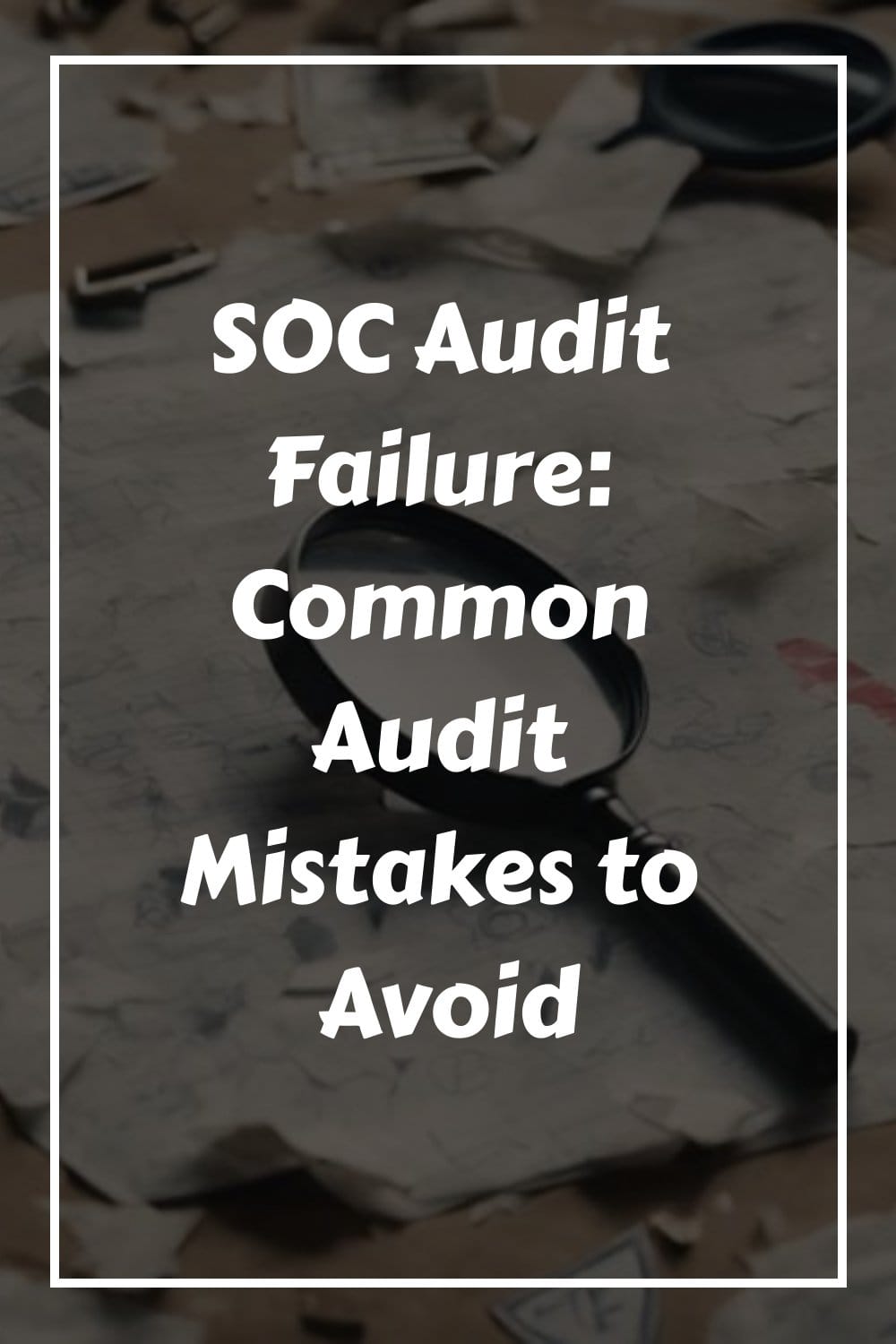Just as Odysseus faced numerous trials on his journey home, you’ll encounter your own set of challenges navigating a SOC audit. You must be aware of common mistakes to avoid them.
Insufficient stakeholder buy-in, lackluster communication, and inadequate scoping can make or break your audit outcome. By understanding these pitfalls, you’re better prepared to secure your organization’s compliance and competitive edge.
Let’s explore how you can steer clear of these errors, ensuring your journey toward SOC audit success isn’t derailed by avoidable obstacles.
Key Takeaways
- Conduct pre-audit readiness assessments to identify and correct control gaps early.
- Ensure accurate scoping and understanding of SOC report requirements to avoid costly adjustments.
- Regularly monitor internal controls and sub service organizations to maintain compliance and security.
- Educate and engage stakeholders on the audit process and compliance significance for better buy-in and support.
Stakeholder Buy-In Importance
Securing stakeholder buy-in is essential, as it sets a positive tone for audit success from the top down. When you’re aiming for freedom in operations and the agility to move quickly, understanding the strategic value of a SOC report is your ticket. It’s not just about compliance; it’s about leveraging this process to sharpen your competitive edge.
Linking the audit to your sales targets can turn a mundane compliance task into a powerful tool in your team’s arsenal. Encourage them to see beyond the immediate demands of the audit. Highlight how adopting robust security practices, like vulnerability scanning and secure coding, doesn’t just tick a box—it fortifies your defenses and showcases your commitment to excellence. This isn’t just an audit; it’s an opportunity.
Effective Communication Strategies
To ensure your team’s full support during an audit, it’s crucial to communicate the process and its benefits clearly and efficiently. You’ve got the power to transform the audit from a dreaded task into a valued asset.
Start by demystifying the audit process. Break it down into simple, actionable steps that everyone can grasp and rally behind. Highlight how the audit’s success directly feeds into your team’s freedom to innovate and outpace competitors. Make it clear that everyone’s role is pivotal and their contribution isn’t just valued but essential.
SOC Report Scoping Essentials
Determining the scope of your SOC report is a critical first step that sets the foundation for a successful audit process. It’s your ticket to freedom from audit headaches and potential failures. Here’s how to nail it:
- Identify Your Services: Zero in on the services you provide. This isn’t just about what you do; it’s about understanding the impact on your clients.
- People, Processes, and Technology: Map out who’s involved, what they do, and the tech they use. Miss one, and you’re asking for trouble.
- Choose Your Report Type Wisely: SOC 1 or SOC 2? It’s not just alphabet soup. Your choice affects everything from your audience to the audit’s focus. Make it count.
Pre-Audit Readiness Assessment
Conducting a pre-audit readiness assessment can significantly enhance your audit’s efficiency by identifying control gaps early on. It’s about taking control of the audit process rather than letting it control you. You’ll pinpoint weaknesses before they become hurdles, ensuring you’re not caught off guard. This proactive approach not only saves time but also empowers you to address issues on your own terms. Here’s a quick guide to what matters most in your readiness assessment:
| Focus Area | Why It Matters |
|---|---|
| Control Gaps | Identifies weaknesses early, preventing surprises. |
| Policy Review | Ensures all guidelines are up-to-date and comprehensive. |
| Evidence Collection | Streamlines audit by preparing documentation in advance. |
| Scope Verification | Confirms audit covers all necessary areas, avoiding scope creep. |
| Risk Identification | Highlights areas needing immediate attention before the audit. |
Embrace this phase as your chance to shine, turning potential pitfalls into opportunities for improvement.
Addressing Control Failures
Building on the foundation of a pre-audit readiness assessment, addressing control failures is your next step in fortifying your audit process. You’re not just checking boxes; you’re building a resilient system that stands up to scrutiny and safeguards your operations.
Here’s how you can tackle this head-on:
- Identify and Prioritize: Quickly spot where things went sideways. Focus first on the big issues that can derail your audit.
- Implement Fixes: Don’t just patch; solve. Make those necessary changes that get to the root of the problem.
- Educate and Communicate: Ensure everyone’s on board. A quick fix won’t stick unless your team understands the why and the how.
Freedom in your audit process means taking control of these failures and turning them into strengths.
Asset Inventory Management
Accurately managing your asset inventory often serves as the backbone for ensuring compliance and enhancing security measures within your organization. You’ve got to keep a tight ship, knowing every piece of hardware and software you’re juggling.
It’s not just about listing what you’ve got; it’s ensuring each asset is properly classified, tracked, and secured from potential threats. Don’t let your guard down; rogue machines or outdated software can slip through the cracks, posing serious security risks.
Implementing a robust inventory management process isn’t just a checkbox for compliance; it’s your frontline defense. Choose a tool that fits your needs, and don’t skimp on regular checks. Remember, it’s your freedom on the line if things go south. Stay vigilant, stay secure.
Enhancing External Communications
Improving external communications is essential for bolstering your organization’s security posture. When you’re aiming to thrive in a world that demands freedom, ensuring robust external communications isn’t just an option; it’s a necessity. Here’s how you can elevate your game:
- Prioritize Transparency: Let your stakeholders know about your security measures. Transparency breeds trust, and trust is paramount.
- Adopt Cutting-edge Encryption: Out with the old (bye, SSLv3 and TLS 1.0/1.1), and in with the new. Secure your communications with the latest encryption standards to safeguard data.
- Regularly Update Stakeholders: Don’t leave your vendors and customers in the dark. Keep them informed with regular updates on security practices and any changes in protocols.
Embrace these steps to not just avoid audit pitfalls but to champion the cause of freedom and security.
Ensuring Separation of Duties
Ensuring separation of duties is crucial to mitigate risks in your organization’s processes. It’s about setting up your team so everyone’s not stepping on each other’s toes, but rather, working together to catch mistakes or any sneaky business before it harms your operations. Here’s a quick guide to get you started:
| Role | Responsibility |
|---|---|
| Creator | Drafts changes or requests. |
| Approver | Reviews and approves the work. |
| Implementer | Puts the approved changes into action. |
| Auditor | Checks the work for compliance and correctness. |
Internal Control Monitoring
Building on the emphasis on separation of duties, it’s crucial you regularly monitor internal controls to maintain your system’s integrity and compliance. This isn’t just about ticking boxes; it’s about ensuring your freedom to operate without unexpected hitches.
Here’s how you can keep tabs effectively:
- Automate Where Possible: Leverage technology to automate routine monitoring tasks. It’ll save you time and reduce human error.
- Schedule Regular Reviews: Don’t wait for the audit period. Schedule monthly or quarterly reviews to stay ahead.
- Empower Your Team: Ensure everyone knows their role in control monitoring. A team that understands its importance in the bigger picture is a team that excels.
Subservice Organization Oversight
To effectively manage your company’s security and compliance posture, you’ll need to closely monitor and evaluate the performance of any subservice organizations you rely on. Don’t box yourself in by overlooking their role in your operations. Remember, their mistakes can directly impact your freedom to operate without compliance headaches.
Ensure they’re not just meeting but exceeding their obligations. Demand transparency and regular reports on their controls and vulnerabilities. Collaborate, but also verify through audits or assessments. It’s your right to demand excellence for the sake of your company’s integrity.
Frequently Asked Questions
How Do Changes in Regulatory Frameworks Impact the SOC Audit Process and Its Requirements?
When regulatory frameworks change, you’ve got to adapt your SOC audit process and its requirements. These changes can tighten security controls or introduce new compliance standards, impacting how you prepare and execute your audits.
What Are the Specific Challenges and Considerations for Cloud-Based Services Undergoing a SOC Audit?
Ironically, you’d think cloud services float above audit troubles, but no. You must nail down scoping, engage stakeholders, and prep thoroughly. Freedom from audit woes means embracing the grind of readiness and continuous oversight.
Can an Organization Perform a SOC Audit Internally, or Must It Always Be Conducted by an External Auditor?
You can’t perform a SOC audit internally; it must be conducted by an external auditor. This ensures an unbiased review, keeping your organization compliant and secure. It’s a crucial step for maintaining trust and integrity.
How Does Cultural and Organizational Structure Influence the Effectiveness and Outcomes of a SOC Audit?
Your company’s culture and structure greatly impact a SOC audit’s success. Open communication and clear roles boost effectiveness, while silos and resistance can hinder it. Embrace change and teamwork for better outcomes.
What Role Do Third-Party Vendors Play in the SOC Audit Process, and How Can Their Involvement Either Help or Hinder the Audit’s Success?
Third-party vendors play a crucial role in your SOC audit process. They can either bolster your audit’s success by meeting compliance standards or hinder it if they don’t align with your security and control requirements.
Conclusion
In the epic saga of your SOC audit journey, dodging these pitfalls isn’t just smart; it’s legendary.
By rallying the troops (a.k.a. stakeholders) with the zeal of a war cry, speaking the sacred tongue of effective communication, and navigating the treacherous waters of SOC report scoping, you’re not merely preparing; you’re embarking on an odyssey.
Thwart control failures like a hero of yore, and watch as your organization transforms from the humble village to the impenetrable fortress of compliance and security.
This isn’t just an audit; it’s your crowning glory.









